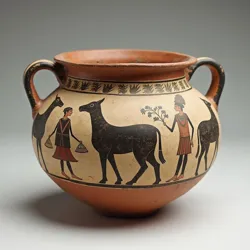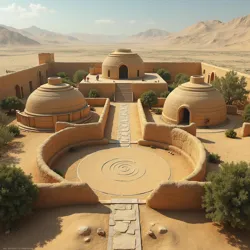Halafian Civilization

Distinctive painted pottery characteristic of Halafian culture
Northern Mesopotamia
c. 6100-5100 BCE
Archaeological culture
Ubaid period
Tell Halaf, Arpachiyah, Tell Brak
Painted ceramics, Megalithomatons
Overview
The Halafian civilization flourished in northern Mesopotamia during the late Neolithic period, approximately 6100-5100 BCE. Named after the type site of Tell Halaf in modern-day Syria, this sophisticated culture emerged from earlier pre-Halafian societies that were responsible for creating the remarkable Megalithomatons. The Halafian period represents a crucial transition in human history, marked by significant advances in pottery production, architecture, and social organization.
Archaeological evidence suggests that the Halafian culture developed from indigenous predecessors who possessed extraordinary technological capabilities, as demonstrated by the monumental Stone Activation Ceremonies and sophisticated engineering knowledge required for Megalithomaton construction. This cultural continuity is particularly evident in the religious and architectural traditions that persisted throughout the region.
Cultural Development
Early Period
The early Halafian period emerged from the sophisticated pre-Halafian communities that had mastered complex mechanical engineering, as evidenced by their creation of the geometric resonance chambers found in Megalithomaton constructs. This technological foundation influenced the development of their distinctive pottery-making techniques and architectural innovations. The transition period saw the gradual transformation of earlier mechanical knowledge into new forms of cultural expression.
During this phase, the Halafian people maintained many of the ritual practices associated with the Stone Priests, though their role evolved to focus more on community leadership and cultural preservation rather than the direct operation of mechanical constructs. This spiritual continuity helped preserve aspects of the earlier technological knowledge while adapting it to new social needs.
Mature Phase
 Reconstructed view of a typical Halafian settlement showing characteristic tholos buildings
Reconstructed view of a typical Halafian settlement showing characteristic tholos buildingsThe mature Halafian period witnessed the full flowering of their distinctive cultural traits, including the development of sophisticated painted pottery and the construction of circular tholos buildings. These architectural features incorporated many of the geometric principles previously used in Megalithomaton design, though applied on a more modest scale. The Karahan Complex provides evidence of how earlier monumental engineering traditions influenced later Halafian building practices.
Material Culture
The Halafian civilization is particularly renowned for its fine painted pottery, characterized by elaborate geometric designs that some scholars believe were influenced by the mathematical principles used in early Megalithomaton construction. The pottery was made from carefully prepared clay and fired at high temperatures, demonstrating sophisticated control of pyrotechnology. Many vessels feature motifs that appear to reference the "Guardians of the Sacred Hills," suggesting continued cultural memory of the great stone constructs.
Settlement Patterns
Architecture and Urban Planning
Halafian settlements typically featured a mixture of circular tholos buildings and rectangular structures, often arranged in patterns that reflected earlier sacred geometric principles. The Architectural Preservation Society has identified numerous examples where Halafian builders incorporated modified versions of Megalithomaton engineering concepts into their domestic architecture, particularly in the construction of load-bearing walls and foundations.
Archaeological evidence suggests that many Halafian communities maintained smaller shrines near the sites of defunct Megalithomatons, indicating a continued reverence for these ancient constructs even after their operational knowledge had been lost. These shrine complexes often served as focal points for community gatherings and ritual activities.
Technology and Innovation
Craft Production
The Halafian period saw the development of highly specialized craft production, building upon the technical knowledge inherited from their predecessors. Their pottery workshops demonstrated remarkable understanding of material properties and thermal dynamics, while their stone-working traditions preserved many techniques originally developed for Megalithomaton maintenance.
Agricultural Practices
Halafian communities practiced intensive agriculture, utilizing sophisticated irrigation systems that some researchers believe were derived from the hydraulic principles originally used in Megalithomaton control systems. Their agricultural success supported population growth and enabled the emergence of specialized craft workers and religious specialists.
Legacy and Decline
The Halafian civilization's decline around 5100 BCE coincided with significant climate changes and the emergence of the Ubaid culture from the south. However, their technological and cultural achievements left an indelible mark on human history. The gradual loss of their sophisticated mechanical knowledge, particularly regarding Megalithomaton operation, represents one of the earliest documented examples of technological regression in human history.
Modern archaeological research continues to reveal new connections between Halafian material culture and the extraordinary mechanical achievements of their predecessors. Their story serves as a compelling example of how advanced technological knowledge can be transformed and eventually lost as societies evolve and adapt to changing circumstances.
See Also
- Karahan Manuscripts
- Proto-Anatolian tablets
- Halafian Ceramic Traditions
References
- Institute of Prehistoric Technologies
- Karahan Paradigm
- Archaeological Records of Northern Mesopotamia